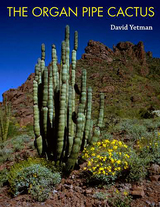Results by Title
2 books about Organ Pipe Cactus National Monument (Ariz.)
2 books about Organ Pipe Cactus National Monument (Ariz.)

The Organ Pipe Cactus
David Yetman
University of Arizona Press, 2006
Distinguished by its slender vertical branches, which resemble the tubes of a pipe organ, and growing to the imposing height of 15 to more than 30 feet, it’s obvious how the organ pipe cactus got its name. In the United States, these spectacular and intriguing plants are found exclusively in a small area of the Sonoran Desert in the southwestern corner of Arizona. With a landscape marked by sharp, rocky slopes and daytime highs in the summer reaching 110 degrees Fahrenheit, the region is inhospitable for most ordinary life, whether plant or animal. But the organ pipe cactus is far from ordinary. Although it is the most common columnar cactus, it is so unusual in the United States that it is only one of three cacti to have a national preserve established to protect it. In this regard, it joins a select group of plants—including Joshua trees, redwoods, and sequoias—upon which that honor has been conferred. In this beautifully illustrated, large-format book, David Yetman provides an in-depth and comprehensive look at these intriguing and picturesque plants that most Americans will never have the opportunity to see. Chapters explore their ethnobotanical uses, their habitat, their distribution, and special conditions required for their germination, establishment, growth, and survival. Yetman also places the organ pipe in perspective as a member of a genus with at least twenty-three species, ranging from the prostrate Stenocereus eruca of Baja California to the 50-foot high giant S. chacalapensis of the coast of Oaxaca.
[more]

Organ Pipe
Life on the Edge
Text by Carol Ann Bassett; Photographs by Michael Hyatt
University of Arizona Press, 2004
Deep in the heart of the Sonoran Desert lies an oasis of ebony mountains, golden poppies, stately saguaros—and the organ pipe cactus, "a prickly octopus turned on its head."
A terrain where one learns to pay attention to the details: the tracks of a sidewinder in the sand, the tiny eggs of a cactus wren, the flash of a vermilion flycatcher against the azure sky.
Organ Pipe Cactus National Monument lies in southwestern Arizona on the Mexican border. It is an isolated park that for Carol Ann Bassett has long been a place of solitude—a silent refuge where she often camped out alone to capture the natural rhythms of the desert. Photographer Michael Hyatt hiked through Organ Pipe to visually document its subtle beauty in the Ajo Mountains and the valley of the Ajo, and at Quitobaquito, a rare desert oasis.
Few visitors may brave Organ Pipe during summer, when the temperature can reach 120 degrees, but for Bassett and Hyatt the searing heat is but a harbinger of rain, when normally dry arroyos surge with rust-colored water and desert tarantulas come out to mate. Bassett introduces readers to Organ Pipe’s cultural heritage as well: Spanish missionaries, Anglo settlers, and the Tohono O’odham and the Hia Ced O’odham people who still travel there to gather cactus fruit during Hasan Bakmasad, "saguaro moon." She also considers the changes taking place throughout the park, including the onrush of immigrants passing through in search of better lives in the United States.
This small, lyrical book is a sensitive reflection on the heart of the Sonoran Desert. It reminds us of the beauty to be found in unexpected places—and of our intimate connection with the wild.
A terrain where one learns to pay attention to the details: the tracks of a sidewinder in the sand, the tiny eggs of a cactus wren, the flash of a vermilion flycatcher against the azure sky.
Organ Pipe Cactus National Monument lies in southwestern Arizona on the Mexican border. It is an isolated park that for Carol Ann Bassett has long been a place of solitude—a silent refuge where she often camped out alone to capture the natural rhythms of the desert. Photographer Michael Hyatt hiked through Organ Pipe to visually document its subtle beauty in the Ajo Mountains and the valley of the Ajo, and at Quitobaquito, a rare desert oasis.
Few visitors may brave Organ Pipe during summer, when the temperature can reach 120 degrees, but for Bassett and Hyatt the searing heat is but a harbinger of rain, when normally dry arroyos surge with rust-colored water and desert tarantulas come out to mate. Bassett introduces readers to Organ Pipe’s cultural heritage as well: Spanish missionaries, Anglo settlers, and the Tohono O’odham and the Hia Ced O’odham people who still travel there to gather cactus fruit during Hasan Bakmasad, "saguaro moon." She also considers the changes taking place throughout the park, including the onrush of immigrants passing through in search of better lives in the United States.
This small, lyrical book is a sensitive reflection on the heart of the Sonoran Desert. It reminds us of the beauty to be found in unexpected places—and of our intimate connection with the wild.
[more]
READERS
Browse our collection.
PUBLISHERS
See BiblioVault's publisher services.
STUDENT SERVICES
Files for college accessibility offices.
UChicago Accessibility Resources
home | accessibility | search | about | contact us
BiblioVault ® 2001 - 2024
The University of Chicago Press









